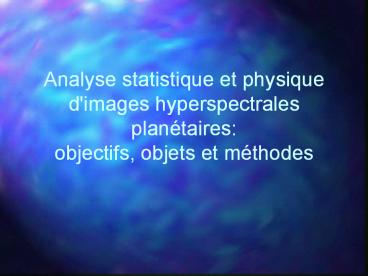Analyse statistique et physique d'images hyperspectrales plan PowerPoint PPT Presentation
Title: Analyse statistique et physique d'images hyperspectrales plan
1
Analyse statistique et physique d'images
hyperspectrales planétaires objectifs, objets
et méthodes
2
Icy and mineral surfaces of the Solar
System scientific interest
The surfaces of evolved planets and satellites
are boundary layers
marked by numerous internal or external
geophysical processes
Their physical, chemical and structural properties
characterize the nature and the evolution of
these processes
dark materials produced by irradiation of SO2 ice
by magnetospheric particles
lava flows resulting from the upwelling of
asthenospheric magma
volatile deposits condensed from the atmosphere
after eruption and transport of volcanic gases
3
Remote sensing of planetary surfaces by NIR
imaging spectroscopy concepts
The imaging spectrometers measure the spectrum of
the solar light or of the thermal radiation
respectively reflected or emitted by a planetary
surface for an array of discretized pixels
distributed throughout the scene
Principal characteristics of the imaging
spectrometer OMEGA (Mars Express)
4
Remote sensing of planetary surfaces by NIR
imaging spectroscopy The bidirectional
reflectance
The bidirectional reflectance of a medium is
defined as the radiance emerging in a given
direction from the surface illuminated by a
collimated irradiance per unit incident
irradiance.
5
Remote sensing of planetary surfaces by NIR
imaging spectroscopy nature of retrieved
scientific information
An imaging spectrometer samples the bidirectional
reflectance (BRDF) of the observed surface both
in the
spectral dimension
angular dimension
6
Spatial complexity at all scales
1 cm
7
Remote sensing of planetary surfaces by NIR
imaging spectroscopy physics of spectral signal
formation
absorption
8
The analysis of hyperspectral dataa possible
methodological scheme
Spectroscopic identification
coupling
Statistical methods
Segmenting the scene into spatial units Mapping
of their physical, chemical and structural
properties
Modeling and inversion
Experimental data
coupling
9
Détection automatique composants - classification
spectroscopique
wavanglet
CO2 glace
CO2H2O
minéraux
H2O glace
10
Réduction de dimensionnalité et classification
statistique
MNFPPI
11
spectribase SYSPIMS
Modélisation - caractérisation physique
12
OMEGA/Mars Express
OMEGA instrument is still operating well with
almost no aging
Collection du LPG (images prétraitées et
calibrées)
3200 séquences dobservation contenant des
volatiles (40 des images)
13
CRISM/MRO
- 25 hour-orbit the spacecraft is circling the
planet roughly once per martian sol (day) - Periapsis altitude of the orbit 106 kilometers
- Periapsis is near 75 degrees south latitude in
the South Pole region of Mars.
This summer, the CRISM team will continue
planning for the next round of spacecraft
checkouts and instrument calibrations which begin
when the aerobraking phase ends in September and
refining the software it will use to operate the
instrument and collect data. The mission primary
science phase, set to last two years, starts in
early November.

